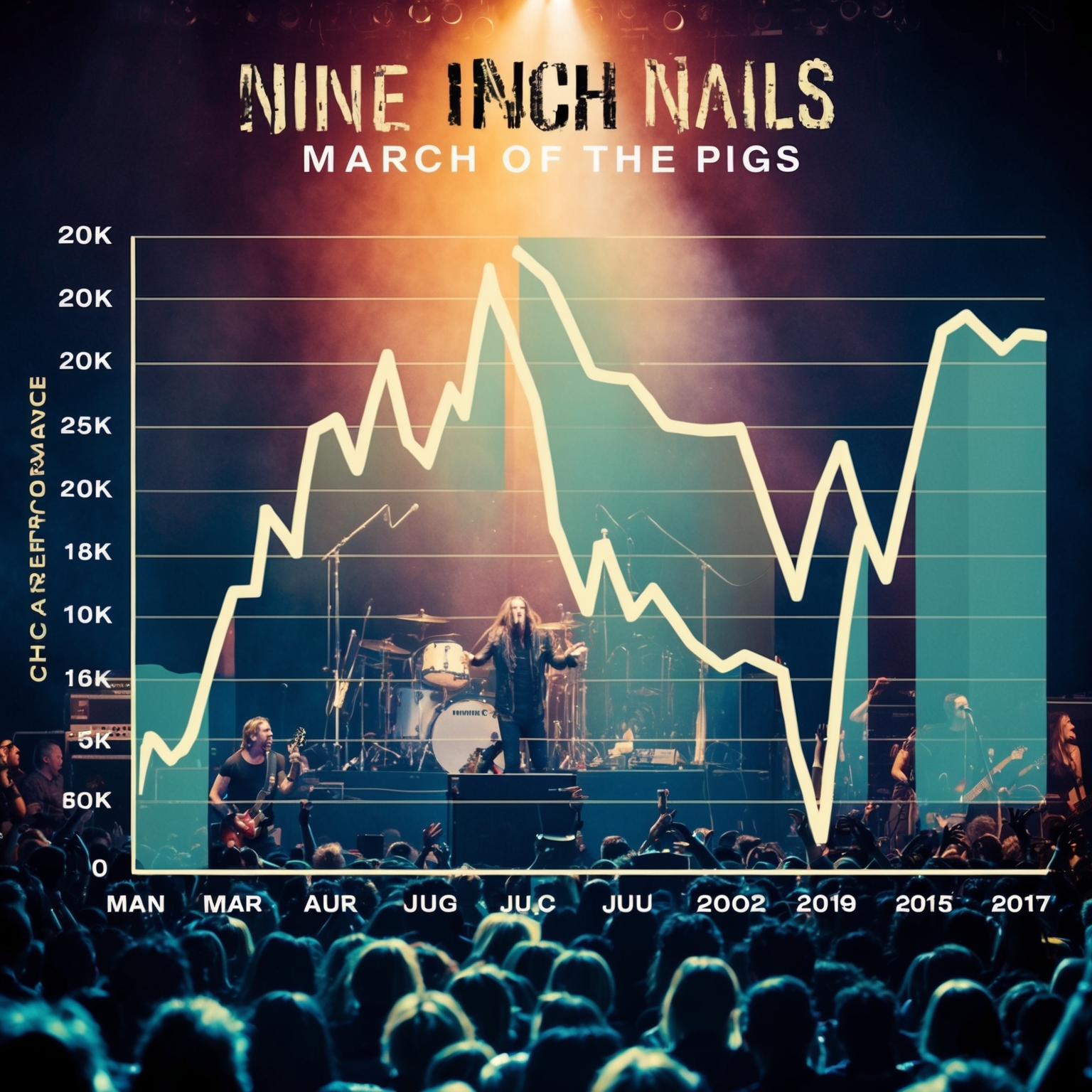Nine Inch Nails: The Evolution of Industrial Rock Pioneers
Explore the creative force behind Nine Inch Nails and the era-defining impact of ‘March of the Pigs’ on industrial rock.

Nine Inch Nails, often abbreviated as NIN, is a band that has left an indelible mark on the music industry with its unique blend of industrial rock, electronic, and alternative music. The one-man brainchild of Trent Reznor, the band debuted in 1989 and quickly established a reputation for intense, thought-provoking music. Perhaps no other song exemplifies their ethos better than ‘March of the Pigs’, a track from their 1994 album, ‘The Downward Spiral’. This song has been instrumental in defining the band’s sound and cementing their place in the annals of music history.
Trent Reznor, born in Mercer, Pennsylvania, was a multi-talented musician from an early age. He played piano, saxophone, and tuba in his youth, and his passion for music led him to enroll in theater studies at Allegheny College. Reznor’s early career involved stints in various bands, but it was his move to Cleveland, Ohio, that marked the genesis of Nine Inch Nails. There, he worked as a janitor at Right Track Studio, using his after-hours access to begin crafting what would become the sound of NIN.
In the early 1990s, the music scene was diverse, with genres like grunge, hip hop, and alternative rock gaining popularity. However, Nine Inch Nails cut through the noise by offering something novel. ‘March of the Pigs’, with its relentless energy and raw sound, was a departure from mainstream music, and it was a bold statement that marked NIN’s definitive embrace of the industrial rock genre. The release period of ‘March of the Pigs’ coincided with collaborations between Reznor and other artists, such as his work with Marilyn Manson, reflecting a deeper dive into the darker, more avant-garde music that would define that era.
While Nine Inch Nails is often synonymous with Reznor, live performances have historically included a band to bring the layered studio sound to life. Early members, like guitarist Richard Patrick, contributed to the live dynamic, although the band lineup has evolved over time. The synergy between Reznor’s creative production and the band’s live interpretation has been critical to their enduring success and has played a vital role in the impact of songs like ‘March of the Pigs’ on audiences worldwide.
Trent Reznor: The Visionary Behind “March of the Pigs”
Explore the creative genius of Trent Reznor, the composer of Nine Inch Nails’ “March of the Pigs,” and understand his profound impact on the song’s formidable presence in the music world.

When discussing the composer of “March of the Pigs,” it is impossible to overlook the immense influence of Trent Reznor, the mastermind behind Nine Inch Nails. Known for his innovative approach to music, Reznor’s career has been marked by a dedication to pushing the boundaries of industrial rock. His musical journey began at an early age, and after honing his skills working with various bands and gaining industry experience, he ultimately focused on creating what would become Nine Inch Nails in 1988.
Reznor’s style is synonymous with the sound of Nine Inch Nails, emphasizing a blend of industrial, electronic, and alternative rock influences. Drawing inspiration from bands like Ministry and Skinny Puppy, as well as classical and jazz elements, Reznor crafts music that is both intense and layered, perfectly capturing the raw emotions often present in his work. His ability to meld these diverse influences into a cohesive and distinctive sound is what sets him apart as a composer.
Throughout his career, Reznor has often taken a solitary approach to music production, serving as the primary composer, performer, and producer for Nine Inch Nails. However, he has also engaged in meaningful collaborations, such as his partnership with Atticus Ross, which has expanded his musical horizons and led to noteworthy projects outside of Nine Inch Nails. Reznor’s role in “March of the Pigs” was comprehensive, involving not only the composition of the track’s aggressive soundscape but also its lyrical themes, reflecting his integral part in crafting its legacy.
Recognizing “March of the Pigs”: Honors, Covers, and Media Appearances
Explore how “March of the Pigs” extends its influence beyond awards, making its mark through acclaimed covers and strategic media placements.

“March of the Pigs” by Nine Inch Nails may not be the typical song that grabs the headlines for its collection of awards and nominations, yet its artistic influence and undeniable impact on both fans and fellow musicians make it a seminal part of the alternative rock canon. While the industrial rock genre doesn’t traditionally dominate award circuits, “March of the Pigs” has garnered respect and accolades in its own right through its powerful sound and cultural relevance.
Despite not claiming any major traditional music awards like the Grammys, the song has been widely acclaimed by critics and fans alike. It received praise for its raw energy and unique structure. Rolling Stone, for instance, highlighted its influence on the genre, ensuring its place in their lists of essential tracks for understanding the evolution of industrial rock.
Interestingly, the track’s influence extends beyond critique, as artists across various genres have recognized its robust creativity through covers. Bands like Between the Buried and Me and others have paid homage by covering this track, bringing their own artistic flair while respecting the original’s frenzied energy. Such renditions further cement the song’s enduring legacy and cross-genre impact.
The song’s distinctive sound has also found a place in various forms of media. Although not as mainstream as other tracks, “March of the Pigs” has made appearances in television, often used to convey intense energy or gritty atmospheres, reflecting the song’s dynamic pace and relentless beat. It’s a testament to how Nine Inch Nails’ work often meshes seamlessly with visual storytelling, adding depth and emotion to scenes that require an industrial edge.
Chart Trajectory and Influence of ‘March of the Pigs’
Explore how ‘March of the Pigs’ by Nine Inch Nails made its mark on charts, influenced the band’s trajectory, and impacted the cultural and economic landscape of the 90s music scene.

Chart Trajectory and Influence of ‘March of the Pigs’
Released in February 1994, ‘March of the Pigs’ by Nine Inch Nails stormed into the music scene as the lead single from their critically acclaimed album, ‘The Downward Spiral’. Though it didn’t achieve the towering commercial success of mainstream pop hits at the time, the track made a notable impression on various charts. It peaked at number 6 on the Billboard Modern Rock Tracks, showcasing its strong appeal within the alternative and rock communities.
When compared to other tracks of its era, ‘March of the Pigs’ held its ground firmly among genres that often dominate the mainstream charts. While it may not have climbed to the zenith of Billboard Hot 100, its reception marked significant tonal shift towards industrial rock, spearheaded by Nine Inch Nails in the 90s. This track was pivotal in carving out their path of success, laying groundwork for subsequent hits like ‘Closer’, which would elevate the band’s stature in popular music.
In terms of marketing and promotions, the song was part of a unique campaign that included a visually striking music video and gripping live performances. Notably raw and energetic, their performance on MTV’s ‘Live and Loud’ resonated with audiences, further bolstering its reach. Despite mixed reviews from critics at the time, with some labeling it too abrasive for the mainstream, the track’s enduring impact on popular culture cannot be overstated. It further cemented Nine Inch Nails’ role in influencing a line of industrial genres, thereby ensuring its place within the rock pantheon.
Economic aspects also highlight the track’s significance. While the single itself was not a major sales juggernaut, it greatly contributed to the parent album’s million-plus units sold, reinforcing the band’s status as influential artists in the alternative and industrial domains. This success subsequently translated into sold-out tour dates, underscoring the economic footprint the track has had on the band’s earnings and evolving narrative in the music industry.
Exploring the Visual Chaos: The Impactful Music Video of ‘March of the Pigs’
The ‘March of the Pigs’ music video captures the chaotic energy of Nine Inch Nails through raw performance and minimalist visuals, leaving a lasting impact on viewers.

The music video for Nine Inch Nails’ ‘March of the Pigs’ is as raw and intense as the song itself, an embodiment of the chaos and aggression that Trent Reznor expertly crafts within his musical universe. Directed by Peter Christopherson, the video captures the spirit of the song through its minimalist yet powerful approach. Featuring the band performing in a stark white room, the video dives headfirst into the energy and fury of the track, mirroring its frantic pace and visceral texture.
The visuals of the ‘March of the Pigs’ video are driven by an emphasis on raw performance, unpolished and deliberately chaotic. It eschews elaborate set designs or narratives in favor of a direct confrontation with the music itself. This approach effectively ties the visual experience to the track’s aggressive industrial sound. The chaotic camerawork, characterized by rapid zooms and quick cuts, adds to the dizzying sensation of the song, making the viewer feel as though they are part of the live performance, absorbing the chaotic energy firsthand.
Reception to the music video was mixed, with some critics praising its minimalist approach and raw energy, while others found it overwhelming. Despite this, the video contributed to the song’s enduring popularity, reinforcing Nine Inch Nails’ reputation for pushing artistic boundaries. The video’s production, involving just the band’s live performance in a studio setting, aligns seamlessly with the band’s avant-garde ethos. While there are no celebrity cameos, the focus remains squarely on Reznor and his intense presence, which is more than enough to captivate the audience and leave a lasting impression.
Anatomy of ‘March of the Pigs’: A Breakneck Sonic Assault
March of the Pigs’ showcases Nine Inch Nails at their most frenetic. The song’s structure—characterized by its shifting time signatures and relentless tempo—captures the chaotic energy of the band’s sound during this era.

‘March of the Pigs’ is a rollercoaster of a song that hurls the listener into Nine Inch Nails’ defining sound. The song is constructed in a somewhat unconventional manner, starting with a frenetic, high-tempo introduction. It is primarily composed in the key of 6/8 time signature during the verses, shifting to a more stable 4/4 during its chorus, creating a jarring but fascinating energy contrast that reflects the chaos and tension expressed in the lyrics.
The tempo is unrelenting, clocking in at 269 beats per minute, a veritable tempest that mirrors the intensity of the emotions Trent Reznor channels through his composition. The structure flirts with chaos—verse sections are packed with distorted guitars and electronic elements that generate an almost relentless drive, only to yield to the minimalism of piano-dominated choruses despite remaining high in energy.
Instrumentation plays a crucial role in delivering the raw, visceral sound for which the song is known. Core elements include layered distorted guitars, aggressive drumming that at times borders on industrial percussion, and synthesizers that both add depth and enhance thematic discordance. When comparing this track to other songs in the Nine Inch Nails discography, it draws a line from earlier works’ raw, unrefined aggression to the more polished chaos found in later albums. This track exemplifies a pivotal point in Reznor’s artistic journey, emphasizing a transition towards blending traditional rock elements with industrial textures with increasing complexity.
Delving into the Raw Intensity of Nine Inch Nails’ ‘March of the Pigs’
Nine Inch Nails’ ‘March of the Pigs’ offers a visceral exploration of themes like greed and societal decay, wrapped in raw intensity and metaphorical lyricism.
Crawl right up on your knees
Please greed feed (no time to hesitate)
I want a little bit I want a piece of it I think he’s losing it
I want to watch it come down
Don’t like the look of it, don’t like
The taste of it, don’t like the smell of it
I want to watch it come down
All the pigs are all lined up
…
******* This Lyrics is NOT for Commercial use *******

“March of the Pigs” by Nine Inch Nails stands as a testament to the raw and visceral nature of 1990s industrial rock. The song’s lyrics grapple with themes of dissatisfaction, greed, and the societal decay, placing the listener at the center of a chaotic and frenzied disillusion. The song resonates with the angst and rebellious undertones that characterized much of the alternative music of its time. Through the lens of a first-person narrative infused with both aggression and desperation, Trent Reznor, the band’s driving force, crafts a scathing critique of materialism and the dehumanizing aspects of modern life.
The narrative arc of “March of the Pigs” is less about telling a clear-cut story and more about evoking a sense of urgency and tension. The lyrics are delivered with an intensity that mirrors the chaotic musical arrangement, enhancing the emotional impact on the listener. Reznor’s use of repetition and command-like phrases such as “step right up” and “crawl right up on your knees” imbues the song with a confrontational energy. This narrative style draws the listener into a relentless march, immersing them in an almost apocalyptic setting where societal norms are scrutinized and challenged.
Nine Inch Nails’ distinctive use of literary devices is prevalent throughout the lyrics. The metaphorical depiction of “pigs” serves as a biting commentary on greed and corruption, while the phrase “watch it come down” hints at a longing for destruction and rebirth. The language is straightforward yet loaded, creating vivid imagery that amplifies the song’s gritty essence. Comparatively, Reznor’s lyricism in “March of the Pigs” shares thematic similarities with other works from the The Downward Spiral album, underscoring themes of disillusionment and existential crisis while solidifying its place within the industrial genre’s narrative landscape.
Cultural references within the song highlight the zeitgeist of the mid-1990s, a time marked by a growing awareness of corporate greed and societal alienation. The relatability of these themes across different audiences adds depth to the song’s enduring appeal. Moreover, the song’s aggressive tone and vivid language evoke strong emotions, which are often echoed in live performances where lyric alterations by Reznor provide further insight into his personal connection with the piece. Fan interpretations frequently suggest an alignment with the song’s harsh critique of modern consumer culture, adding an interesting layer to its multidimensional narrative.
Trent Reznor recorded March of the Pigs in a studio where he was once the janitor. Who knew clean floors led to dirty beats? #IndustrialRockMagic https://bit.ly/3VnSMIE
Click to Tweet







